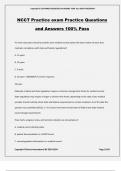Copyright © OLIVIAWEST2024/2025 ACADEMIC YEAR. ALL RIGHTS RESERVED
NCCT Practice exam Practice Questions
and Answers 100% Pass
For how many years should a provider store medical records (select the least number of years that
maintains compliance with state and federal regulations)?
A. 15 years
B. 10 years
C. 5 years
D. 20 years - ANSWER✔✔-Correct response:
10 years
Rationale: Federal and state regulations require a minimum storage time frame for medical records.
State regulations may require a longer or shorter time frame, depending on the state. Every medical
provider should routinely check state and federal requirements to remain compliant. As of the date this
question was submitted (2015), a 7 to 10 year time frame would meet all federal and state medical
record storage requirements.
Flow charts, progress notes, and narrative notation are all examples of
A. medical record charting styles.
B. patient documentation in a SOAP format.
C. recording patient information in a medical record.
Copyright ©Stuvia International BV 2010-2024 Page 1/102
, Copyright © OLIVIAWEST2024/2025 ACADEMIC YEAR. ALL RIGHTS RESERVED
D. patient chart filing systems. - ANSWER✔✔-Correct response:
recording patient information in a medical record.
Rationale: Patient information can be recorded in the medical record in a variety of ways. Progress notes,
flow charts and narrative notation are all effective ways to document a patient's medical information.
The SOAP format is the documentation system chosen by many physicians. S=Subjective patient
interview information, O=Objective information such as vitals, lab values, etc., A=Assessment of the "S"
and "O" data, P=Plan for treatment or follow-up. Medical records of various styles are generally kept in
charts, which are filed according to a filing system.
When measuring oxygen saturation on a child breathing room air, with normal color, and no signs of
respiratory distress, the medical assistant obtains a reading of 79%. Which of the following actions
should the medical assistant take next?
A. supplement the child with oxygen per protocol
B. take a full set of vital signs
C. reposition the finger probe
D. notify the physician - ANSWER✔✔-Correct response:
reposition the finger probe
Rationale: Oxygen saturation (O2 Sat or Pulse Ox) on a child with a structurally normal heart should be
>92% . Patient movement, poor probe attachment, or nail polish can distort the sensor reading during
monitoring. Always observe the child's condition first, and machine reading 2nd when troubleshooting.
O2 saturation should be obtained and documented as part of a full set of vital signs for patients being
evaluated for respiratory conditions.
Copyright ©Stuvia International BV 2010-2024 Page 2/102
, Copyright © OLIVIAWEST2024/2025 ACADEMIC YEAR. ALL RIGHTS RESERVED
Which of the following is the best way to correct AC interference on an ECG?
A. Ask the patient not to move while performing the test.
B. Move the patient to a quiet room.
C. Check that the patient does not have a cell phone close by.
D. Offer the patient a blanket if she is cold. - ANSWER✔✔-Correct response:
Check that the patient does not have a cell phone close by.
Rationale: AC is alternating current interference and it can be caused by a nearby electrical device (such
as a cell phone). Patient movement (either voluntary or shivering from the cold) can cause other artifact
on an ECG, but not the same as AC interference. Moving the patient to a quiet room would not alleviate
AC interference.
Which of the following documents is also called an advanced directive?
A. subpoena
B. informed consent
C. living will
D. assignment of benefits - ANSWER✔✔-Correct response:
living will
Rationale: A living will is a formal document, written in advance, that gives health care professionals
instructions about the patient's medical wishes regarding end of life care, and is the same as an
advanced directive. Assignment of benefits refers to the patient's wishes on who and where they want
their money sent to, a subpoena is an order given to someone who is supposed to go to court, and
Copyright ©Stuvia International BV 2010-2024 Page 3/102
, Copyright © OLIVIAWEST2024/2025 ACADEMIC YEAR. ALL RIGHTS RESERVED
informed consent refers to a document that a patient fills out which gives permission to the healthcare
providers to perform certain tasks or procedures.
Beginning with the infectious agent, place the elements in the correct order of the chain of infection.
(Click and drag the options in the left column to their correct order in the right column).
reservoir host
portal of exit
means of transmission
portal of entry
susceptible host - ANSWER✔✔-Correct response:
reservoir host, portal of exit, means of transmission, portal of entry, susceptible host
Rationale: Infectious diseases are spread through a series of steps known as the "chain of infection". For
an infection to occur and spread, each of the six links of the chain must take place. Removing any link in
the chain will stop the cycle. Therefore, identifying and instituting appropriate actions at different steps
in the cycle will halt the spread of the infection. The chain begins with the infectious agent (bacteria,
virus,etc.) and spreads to a reservoir (place to live, like an animal, insect, water, etc.). The portal of exit is
a way for the microorganism to leave the reservoir (in a cough, feces, etc.) to transmit the disease. The
mode of infection refers to how infectious diseases are spread: by contact, by vehicle, by vector, and by
inhalation. The infectious agent enters a susceptible host through a portal of entry.Correct response:
reservoir host, portal of exit, means of transmission, portal of entry, susceptible host
Rationale: Infectious diseases are spread through a series of steps known as the "chain of infection". For
an infection to occur and spread, each of the six links of the chain must take place. Removing any link in
Copyright ©Stuvia International BV 2010-2024 Page 4/102




